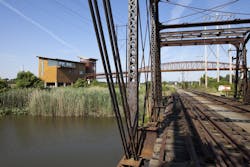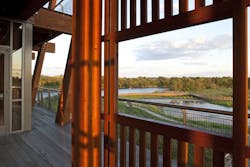Letting your resource take center stage: A guide to thoughtful site selection for interpretive centers
In 1956, the National Park Service began a 10-year initiative, known as Mission 66, to improve the conditions surrounding many National Parks, which were experiencing a boom in attendance after World War II. During this time, the modern interpretive center was born as over 100 were constructed as part of the program. The common approach at the time was to site the building as close as possible to, if not on, the resource. An example of this is the Visitor Center at Gettysburg National Military Park, also known as the Cyclorama Building. The modernist building was purposefully sited directly on North Cemetery Ridge—the location of one of the Civil War’s bloodiest battles—and intended to serve as a bridge connecting past and present. Since then, the thought process has changed to allow visitors to experience the resource as it stands (or stood) without the distraction of modern interventions. For the Cyclorama, that meant it would be razed in 2013 in order to restore the landscape to its 1860s state.
In our experience, thoughtful site selection is never about one factor, but rather a confluence of several components that ultimately present trade-offs for the owner. When evaluating a site for a new building, there are several questions to ask.
— What are you interpreting? Is it a natural feature, a historic event or place, an artifact (built or unbuilt), or is it related to material culture, etc? The subject of interpretation typically plays a critical role in site selection.
— Aside from providing functional space, what role does the architecture play? Depending on the resource, story and mission, the building could range from a clear iconic destination to a more subdued “non-building” allowing the resource to attract one’s full attention.
— What is the current infrastructure? How are your visitors going to get to your site? Are there existing access roads and parking? Are there pathways? Where are the current utilities and other services located? Are you willing to make changes to the current infrastructure in order to build on the most appropriate site?
— What level of sustainability is desired? All buildings should be designed sustainably, however the highest levels (Net Zero, LEED Platinum, and Living Building Challenge) tend to have a bigger impact on site location and orientation.
— What is the budget? For a program to be meaningful, all design decisions must be grounded in the reality of the budget.
While the answers to these questions may seem straightforward, selecting a site that balances these factors without compromising the interpretive mission of an institution can require a bit of creativity and compromise, especially when it comes to managing costs.
A good example of this process can be seen in the preferred siting of the DuPont Environmental Education Center(pictured above), located in Wilmington, Delaware. The building is intended to memorialize the contributions that Russell Peterson, former governor of Delaware and president of the Audubon Society, made to society and interpret one of his proudest achievements—the Russell W. Peterson Urban Wildlife Refuge. Through a detailed site selection process that embraced the above factors, it was determined that the best location for the center was directly adjacent to the wildlife refuge as opposed to a more remote location initially identified by the client. The building has an iconic presence, much like that of Russell Peterson, and poses a clear destination from Wilmington’s River Walk, while providing an elevated platform to take in and interpret the expanse of the refuge. This location also affords an optimal solar orientation and solves a multitude of site safety and infrastructure issues associated with the original site.
Taking the time to consider these questions in the beginning of the design process, preferably as part of programming or a site selection study, can help to make sure that your building is appropriately sited to reinforce the mission of your institution.

